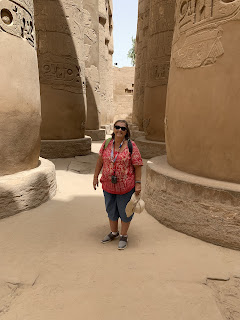After a more than full day yesterday viewing the ancient city of Petra, we woke up this morning ready to attack Egypt.. Today is the Temple of Karnak and the Valley of the Kings. This will be a two part blog as there is so much to see and take in..
 We dock in Safaget about three and a half hours from Luxor.
We dock in Safaget about three and a half hours from Luxor. This is the Eastern Desert. The most desolate desert Ive ever seen.Even Death Valley looks like it has some life in it. It is part of the Sahara desert. I miss the colors of our Sonoran desert!
This is the Eastern Desert. The most desolate desert Ive ever seen.Even Death Valley looks like it has some life in it. It is part of the Sahara desert. I miss the colors of our Sonoran desert! Endless sand punctuated by the occasional hill of sand. And police check points.. In 1997 a group of tourists were killed by extremists and the country was sent into political upheaval.. Now they are constantly vigilant.
Endless sand punctuated by the occasional hill of sand. And police check points.. In 1997 a group of tourists were killed by extremists and the country was sent into political upheaval.. Now they are constantly vigilant. Women waiting for a people mover to take them to market. All along the roadway, the closer we get to the city the more we see activity. There is a canal running along the road filled with water from the Nile.
Women waiting for a people mover to take them to market. All along the roadway, the closer we get to the city the more we see activity. There is a canal running along the road filled with water from the Nile.  the area becomes very agricultural. The desert recedes and with irrigation, the land starts to be productive. All the work is done mostly by hand. Right now is wheat and we saw many out in the fields hand cutting both the wheat and sugarcane.
the area becomes very agricultural. The desert recedes and with irrigation, the land starts to be productive. All the work is done mostly by hand. Right now is wheat and we saw many out in the fields hand cutting both the wheat and sugarcane. In the day time many of the posts were unmanned but when we returned at night everyone of them had a policeman in them.
In the day time many of the posts were unmanned but when we returned at night everyone of them had a policeman in them. The Nile River
The Nile River  Karnak Temple in the background. Construction on the temple began in 1971 BCE in the Middle Kingdom and continued into the Ptolemaic kingdom 305-330 BCE. So this thing is really really old! The history of Karnak is essentially the history of Thebes (Luxor)
Karnak Temple in the background. Construction on the temple began in 1971 BCE in the Middle Kingdom and continued into the Ptolemaic kingdom 305-330 BCE. So this thing is really really old! The history of Karnak is essentially the history of Thebes (Luxor)
 The color on the columns would have been found on everything inside the temple. Our guide was an Egyptologist who worked with the univ. ofArizona when they were here to study and do research and also with the University of Chicago. He has a masters in Egyptian studies and has studied the directional path of the temple by photographing and studying the sunrise and sunset over a five year period to discover that on /or near the winter solstice the sunrises directly over the alter of this temple and at sunset it shines straight through the column room to the alter. Therefore this temple is considered an east/west one. He received his PHD for a study of the physical/metaphysical heart in ancient Egyptians.
The color on the columns would have been found on everything inside the temple. Our guide was an Egyptologist who worked with the univ. ofArizona when they were here to study and do research and also with the University of Chicago. He has a masters in Egyptian studies and has studied the directional path of the temple by photographing and studying the sunrise and sunset over a five year period to discover that on /or near the winter solstice the sunrises directly over the alter of this temple and at sunset it shines straight through the column room to the alter. Therefore this temple is considered an east/west one. He received his PHD for a study of the physical/metaphysical heart in ancient Egyptians.  Al wanted to be able to put his hand in the Nile River! It really is quite a river. The entire civilization that was built because of this water source is impressive to think about!
Al wanted to be able to put his hand in the Nile River! It really is quite a river. The entire civilization that was built because of this water source is impressive to think about!











































No comments:
Post a Comment